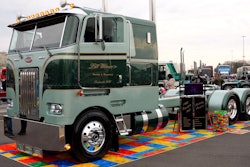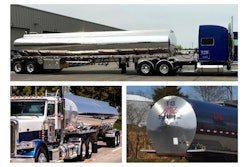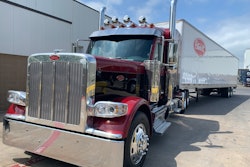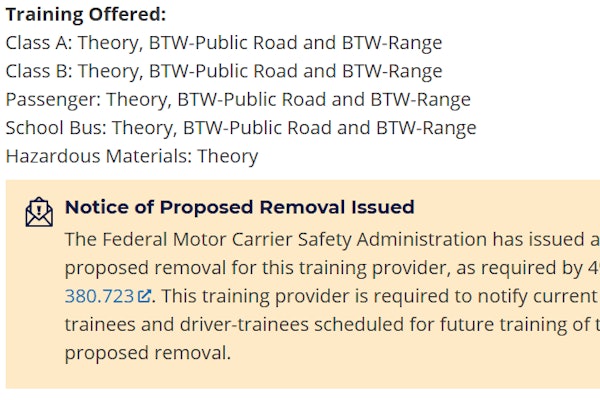Trucking news and briefs for Thursday, April 17, 2025:
Semi-autonomous trucks deployed along I-70
 Two trucks equipped with Kratos Defense platooning technology are operating along I-70 for Ease Logistics.Ohio DOT
Two trucks equipped with Kratos Defense platooning technology are operating along I-70 for Ease Logistics.Ohio DOT
A pair of tractor-trailers with automated truck platooning technology began traveling Interstate 70 between Columbus, Ohio, and Indianapolis, Indiana, this week delivering shipments for third-party logistics provider Ease Logistics.
The platooning deployment is a collaboration between the Ohio Department of Transportation’s DriveOhio initiative and the Indiana Department of Transportation to advance the adoption of truck automation technologies across the Midwest. While the majority of automated vehicle testing to date has been done in regions with warmer and more predictable weather, ODOT said it’s crucial to assess technology performance in adverse weather conditions.
“Everything we do at ODOT is driven by safety. We’re committed to reducing deaths on our roadways and vehicle automation technologies can be part of the solution,” said ODOT Director Pam Boratyn. “Many vehicles on the road today have some degree of automated driving systems, including adaptive cruise control, lane keep assist, and automatic braking."
Such features, she felt, were "designed to improve safety and reduce driver stress.”
The Ease Logistics trucks are equipped with platooning technology provided by Kratos Defense, electronically linking the two vehicles and allowing the driver of the lead vehicle to control the speed and direction of the second truck. During portions of the I-70 trips, the follower truck will automatically steer, accelerate, and brake. Professional drivers will be in the driver’s seat of both trucks throughout the deployment and can turn off the technology system and take over if needed.

“At Kratos, we have adapted advanced automated truck platooning technology -- originally developed for the U.S. military,” said Maynard Factor, VP of Business Development at Kratos Defense.
Factor added that operating along the Columbus-to-Indianapolis corridor allows Kratos “to showcase performance in complex, all-weather conditions essential to Midwest freight operations and accelerates readiness for broad adoption.”
 The trucks are also equipped with cameras and sensors for object detection that enable the following vehicle to automatically adjust its speed, or stop, if another vehicle or object moves in between the trucks.Ohio DOT
The trucks are also equipped with cameras and sensors for object detection that enable the following vehicle to automatically adjust its speed, or stop, if another vehicle or object moves in between the trucks.Ohio DOT
Because the follower truck travels at a closer distance than is typical, the trucks will have a purple light on the cab that is illuminated when they’re in platooning mode to alert law enforcement that they are digitally connected.
The platooning deployment is part of a multi-year $8.8 million project partially funded by a grant from the U.S. Department of Transportation. The project aims to deploy varying levels of automation and integrate these technologies into truck fleets’ daily freight-hauling operations.
[Related: Will autonomous trucks displace drivers? Congress holds hearing on impacts]
Fleet seeks waiver to install brake-activated flashing amber light on equipment
The Federal Motor Carrier Safety Administration is asking for the public’s input on an exemption request from 119-truck Yarde Materials, based in Southington, Connecticut, that would allow the company to install an amber brake-activated pulsating lamp on its trucks in addition to the steady-burning brake lights required by federal regulations.
Current regulations in 49 CFR 393.25(e) require that all exterior lamps (both required lamps and any additional lamps) be steady burning, except for turn signal lamps, hazard warning signal lamps, school bus warning lamps, amber warning lamps or flashing warning lamps on tow trucks and CMVs transporting oversized loads. Another exception is warning lamps on emergency and service vehicles authorized by state or local authorities.
In its request for an exemption from that requirement, Yarde asserted that the use of amber brake-activated pulsating lamps on its trucks, in addition to the steady-burning brake lamps, increases the visibility of their trucks to rear-approaching drivers, thus reducing the likelihood of rear-end accidents.
The fleet would position the flashing amber light on the rear center outside frame rail.
The company cited a Congressional directive from the 2015 highway bill for FMCSA to establish a “Beyond Compliance” incentive program for motor carriers who adopt certain safety technologies. “In the spirit of the Beyond Compliance program, Yarde Metals is seeking to install the lamps as advanced safety features in addition to those that are already required by the existing rule at 49 CFR 393.25(e),” FMCSA noted.
The agency is accepting public comments on the request here through May 19.
[Related: Rewarding owner-operators for safety? FMCSA looking at ‘Beyond Compliance’ incentive program]
Used truck sales volumes continue to climb
Retail used-truck sales volumes continued their ascent in March, ACT Research reported this week, showing a month-over-month increase of 17% from February.
The data was announced in the company's State of the Industry: U.S. Classes 3-8 Used Trucks report.
"Used truck buyers kept their foot on the pedal in March. The market easily outperformed historical seasonality, which called for an increase of 12% month over month," said Steve Tam, ACT Research vice president. "Auction sales were true to form, adding 44% month over month in typical third month of the quarter fashion. Wholesale transactions rounded out the trifecta, expanding 23% month over month."
In total, Tam said March’s preliminary sales were up 28% from February.
"Given the current level of economic and political uncertainty, volumes suggest truckers are taking advantage of available equipment at attractive prices," he added.













